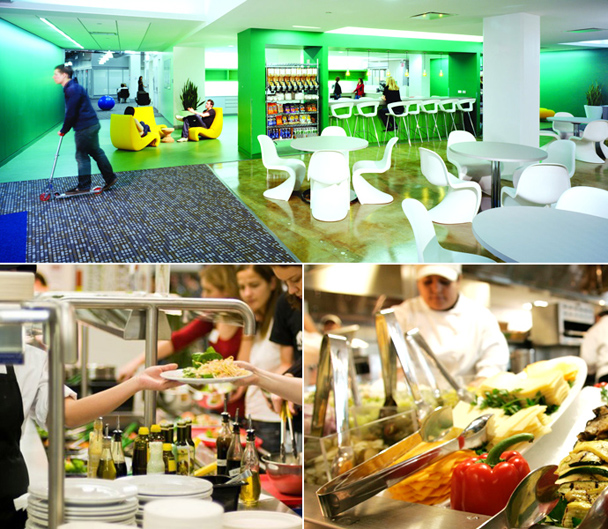When Fortune named Google the best company to work for this year, it nicknamed the tech giant the King of Perks. For Google’s 32,000 employees worldwide, nothing is apparently too good—and so the company provides eyebrow shaping and massage services, nap pods and on-site dry cleaners, bowling alleys, and fitness centers…one location is even equipped with a hockey rink. But the perk the company is most famous for is the high-quality food its employees enjoy—for free.
I’ve long heard from Internet insiders that the proverbial icing on the cake when landing a Google job is the ever-flowing supply of eel-and-avocado rolls, roast pork tacos, and green-tea frozen yogurt. But how good could this meal ticket be? I wondered. And is this perk worth all the hype? After all, many in the industry, from Facebook to Bloomberg, offer food gratis. I headed to company headquarters in Mountain View, just south of San Francisco, to find out for myself.
A quick peek via Google Earth shows that the campus—a multitude of office buildings sprawled across many acres, with mini gardens, lawn chairs, and exercise equipment for decoration—feels more college than corporate. This makes sense given that the company began as a grad-school project of cofounders Larry Page and Sergey Brin at Stanford in 1996. Google officially launched two years later from a nearby garage and soon moved just south of Stanford to Mountain View, eventually expanding to its present-day location in 2004. One of Page and Brin’s first hires for the fledgling venture was a chef: Charlie Ayers, who in a former life fed the Grateful Dead.
Google’s now-famous company mantra, “Don’t Be Evil,” is baked into every aspect of the enterprise, including the corporate food philosophy. Uniting the themes of health (don’t be evil to your body), sustainability (don’t be evil to the land), and community (don’t be evil to your colleagues), Google’s kitchens achieve a breadth and depth of cuisine that would be the envy of many professional restaurateurs.
Google operates more than 100 corporate cafés worldwide—in London, Hyderabad, Buenos Aires, and beyond—yet it is at headquarters that the food program truly flourishes. The Googleplex campus is home to 25 cafés, and when you factor in the well-stocked “micro-kitchens” throughout the work space, employees are always within 150 feet of food. Each café is helmed by its own chef, most hailing from the world of fine dining. The chefs control their own daily menus—adhering to the corporate tenets of healthy, sustainable, and local—and five executive chefs provide oversight.
As directed by Brin and Page, the company maintains that it’s essential to feed the body—and mind—healthy fare. All foods served at Google, from snacks to salad dressings, are color-coded: Green signifies healthiest; yellow, good for you; and red, least healthy. As executive chef Scott Giambastiani puts it, “We make it convenient for people to eat healthy. We’re quietly nudging you with products like organic fruit and greens, and dried fruits.”
Google’s food program also encourages portion control by providing small plates and bowls for meals and stocking single-serving sizes of red-zone items. Healthy treats are displayed at eye level, the optimal spot for impulse buys, while less healthy treats are parked on the bottom shelves, forcing employees to stoop to conquer their sugar addictions.
The same emphasis on smart choices applies to the countless micro-kitchens, stocked with roasted seaweed, edamame, and multigrain baked chips as well as seasonal fruit, low-fat trail mix, squares of dark chocolate, and latte machines. What’s more, employees can work off calories with a vigorous game of Ping-Pong, foosball, or air hockey—also standard equipment in these spaces.
But while you can lead a coder to carrot juice, you can’t make him drink—unless it’s delicious, too. So flavor and variety remain paramount: On the menu at the Evolution Café the day of my visit were Petaluma chicken cacciatore, porcini-encrusted grass-fed beef, whole-wheat spaghetti pomodoro, and Parmesan-creamed onions. Each café features a different menu, with daily themes focusing on international specialties. Most serve breakfast, lunch, and dinner, and some are open on weekends, dishing up everything from sushi to sliders. Chefs think global but use local: Nearly half the produce served is organic, 30 percent of it comes from within 150 miles, and 70 percent is sourced in-state. The supply chain includes community-sponsored agriculture organizations (CSAs) and community-supported fisheries (CSFs), which puts the company’s money where its mouth is and builds local and sustainable cred.



 Pinterest
Pinterest


